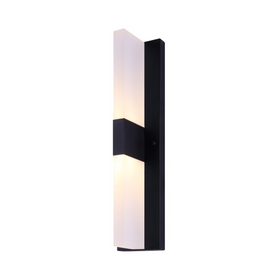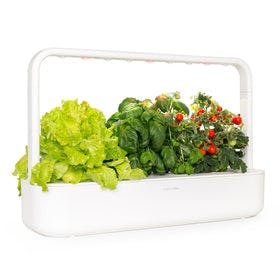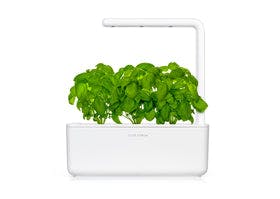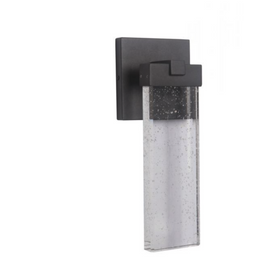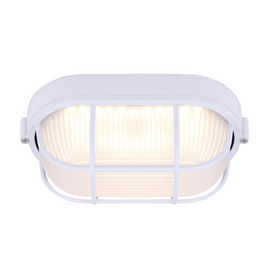
Growing a Garden: Mature Plants
Last Updated: Apr 13, 2025Every plant is different, requiring the proper water, nutrients, and light to satiate their needs. But factors like companionship, gardening methodology, and even a little extra care in their transitional stages can make all the difference.
How to Harden Off Your Seedlings
Your plants have come a long way since being seeds. With strong roots and fully developed leaves, the gradual process of adjusting them to outdoor conditions can begin. This process, called hardening off, gives your plants the best shot at surviving that first week in the ground.
The University of Missouri Extension recommends beginning the hardening off process 10-14 days before anticipated outdoor planting. During this stage, you're taking your plants outdoors daily for a few hours at a time. You want them in a shaded, cool location, protected from the wind.
Remember that your plants have, up to this point, been under fluorescents in climate-controlled rooms. Being placed out in extreme temperatures or exposed to the full power of the sun could damage the tender plants. After a few days in indirect sunlight, you can begin to introduce them to direct sunlight in the morning. Be sure to never leave them out in the intense afternoon sun.
During this time, you are going to want to make sure to reduce the frequency you water your plants. This rationing is essential to limit plant growth as a means to prevent them from becoming rootbound. Make sure your plants never dry out and wilt, this can be damaging.
Once it's time to plant into your garden, be sure to choose the morning on an overcast day. These conditions provide lower ambient temperature and some protection from the sun's rays for the hardened plants. In the several days-to-week following, be sure to protect your establishing plants. Protection can range from placing covers over them on high wind or rain days, cloth if there is an overnight freeze or shade on the exceptionally sunny days. It could take them a while to develop new roots and become capable of supporting themselves.
Table of Contents
- Light, Water, and Nutrients Required for Mature Plants
- How Much Light Do My Mature Plants Need?
- How Much Water Do My Mature Plants Need?
- Do My Plants Need Micronutrients?
- What are Plant Guilds, and What are Their Benefits?
- What Gardening Methods Should I Use?
- Tomato Plant Example

Light, Water, and Nutrients Required for Mature Plants
In previous articles, we looked at light, water, and nutrients as separate fields to discuss in depth. Here, we are going to lump them together for one simple reason. Every mature plant is different. There's no one-size-fits-all strategy here, but plenty of little notes to consider while growing. It will be best for you to do some individualized research into your plants and make sure there aren't any unusual requirements.

How Much Light Do My Mature Plants Need?
Tomatoes, beans, corn, and squash are a few examples of plants that enjoy plenty of light. Most of the vegetables we consume today enjoy full sun because they once acted as annual weeds covering disturbed soil. There are plenty of edibles that can survive in partial sun. Nevertheless, your most common are going to fall into the former category. Rise has delved into breaking down sun requirements if you're unsure what the differences are.
Remember, the light source your plants now use also carries with it some other effects. If your plants are sensitive to heat but still need full sun, consider plant in a place shaded from the warm afternoon sun. Find a place that receives early morning light from the east but is protected by shade from a tree or home. Planting at the edge of a water source adds a little extra reflected light to your garden. It also acts as a heatsink, absorbing thermal radiation all day and radiating it slowly at night.

How Much Water Do My Mature Plants Need?
Some plants enjoy plenty of water, while others can withstand some time without it. When you first transplant into the garden, be sure to water immediately. The plants will struggle initially after transplanting but just observe it. Ensure the soil around your plants never becomes so dried out that the plant wilts.
Some stress in the garden is normal and entices the plant to dig its roots deeper into the ground. Deeper roots mean a better chance of acquiring more water and nutrients. But, prolonged drought conditions can weaken the plant and make it more susceptible to pests. It is a delicate balance and takes some time to notice when it is the right time to water, but don't worry. Over time you learn to anticipate when your plants will need water just by walking the garden.
The water a plant needs is dependant on both the plant and your garden situation. If you're planting in pots, add water slowly and evenly over the top of the container. Aim to stop as you see it begin to trickle out of the bottom. Too much too fast can cause water to quickly go through dry soil, not fully saturating it, or potentially leaching out water-soluble nutrients. If you plan to grow in the ground or a large planter, consider providing enough water to maintain the plant.
Mel Bartholomew, the creator of Square Foot Gardening, recommends using less water, more often. He proposes one cup of sun-warmed water applied to the base of seedlings (multiple helpings for mature plants) near the stem when it looks thirsty. I agree with him in saying that the best way to know when to water the plants is to watch them. Walk your garden daily. If you notice a plant is drooping, give it some water.

What Nutrients Do My Mature Plants Need?
Like with sun and water, every plant has different feeding requirements. Some may need more of one nutrient than others. Let's consider two plants that are heavy feeders, like tomato and cucumber. You're going to need to watch them as they grow and examine both the leaves and the fruit of the plant. The Farmer's Almanac recommends phosphorous-rich solutions to aid with root growth directly after transplanting. Still, after that, a balanced diet produces a hearty plant.
Pulling up a key to nutrient deficiency can help guide you in determining what your plant may need for a more balanced diet. Being able to see what your plant needs by the color of the leaves is beneficial. It allows you to build a connection with your garden as a response to its needs.
A proper feeding schedule can also be found online for various plants. Some purchasable fertilizers come with their feeding-programs that are quite useful. Even with this strategy, I would recommend watching your plants as they develop in the garden. Overfeeding can be just as bad for a plant as underfeeding. So keep a close eye on how your plant grows and make notes, one day, it may help you be your garden's plant health detective.
Do My Plants Need Micronutrients?
Remember, and this is important, be careful if you are adding micronutrients. Plants need trace amounts of things like Boron, Molybdenum, and Zinc. Adding too much of these can not only kill the plant but also poison the soil. For short term gardening, don't worry too much about these micronutrients. If you aim to produce food for your household long term, I would recommend eventually testing your soil for nutrient levels and making small adjustments after that.

What are Plant Guilds, and What are Their Benefits?
A plant guild, also known as companion planting, is defined as a grouping of different plant species that support one another to take advantage of their natural patterns of biodiversity. Selecting proper plant guilds can help alleviate various natural stressors plants experience. Rise has explored tree guilds before, and your garden guilds will function similarly. An example of an old American food guild is that of "The Three Sisters." This Mesoamerican guild takes advantage of the different growing layers of winter squash, corn, and climbing beans.
- With corn growing tall, the climbing beans use their sturdy stalk to work their way closer to the sun.
- Beans, being a nitrogen-fixer, pull nitrogen from the air and put it into the ground around the heavily feeding corn.
- Finally, we have squash, which sprawls out over the earth. This ground cover keeps the soil moist and shaded, perfect conditions for the guilds' root growth.
- And, there is even a fourth sister to consider: the sunflower. This North American native is an unofficial fourth sister as it can be planted with the group and provide an attractant to pollinators.
Proper companion planting like this can potentially reduce the impact of insect damage to plants and increase plant vigor against future attacks. But remember, in nature, plants don't often have just one companion.
Don't be afraid to plant a couple of different vegetables or herbs around your plant and observe over the growing season. See which ones worked best and use those next year. Build a custom guild for your home over several years by learning what plants grow best together in your yard.

Also, similar to the relationship between corn and beans, make sure your plants have some form of trellis if they require it. There is nothing worse than growing something only to realize too late you needed to put in a cage or a trellis to guide its growth. Put the plants that grow tall on the northern end of your planter. When the sun travels along its path south of your garden, the lower crops will receive ample light without the trellis casting a shadow.
Word to the wise: if you're planning on having a container garden, be prepared for challenges.
Container gardening is possible and can yield some fantastic results. Still, you will need to pay more attention to your plants throughout their maturity. Some plants are heavy feeders and may struggle with the limited nutrients you provide in the pot. There are some pots, like terracotta, that will dry out faster than others, making watering a regular chore. Be sure to research container gardening before you begin this process to ensure you know what you may be combating.
Regardless of what growing method you select, one thing that I recommend is to mulch your soil! Whether you are using straw hay, bark, or stone, covering your ground helps protect it from the sun's rays and reduces the rate at which it dries. Think of this as armor for your soil, keeping it and your plant's roots protected from the constant pressure of the sun's rays.

Tomato Plant Example
We've watched our tomato go from a small seed to a tender seedling and now a mature plant - ready to be placed into the ground. You spend almost two weeks hardening off your tomato, ensuring the weather is comfortable enough, and giving it occasional stints in the sun.
After finding the gardening style that works best into your life, you have prepared your garden and are ready to put your tomato plant in the soil. You've decided you wanted to work with a polyculture garden, adding in garlic, parsley, and basil nearby as companions. These plants give a variety of benefits, ranging from pest control to shading the soil from direct sunlight.
Over the next few weeks, you watch your tomato and its close friends. As the plant shows signs of stress, you take a few cups of water and apply them to the base of the plants. Doing this, you notice the plants appear to be showing signs of yellowing. You consult your guide on nutrient deficiencies and find that yellowing leaves with green veins are a sign of nitrogen deficiency. Purchasing a fertilizer of Nitrogen, Potassium, and Phosphorous, you measure out the recommended amount on the bottle. Within a few days, you begin to see your plants bouncing back and beginning to thrive.
After a few weeks, the noticeable yellow flowers of the tomato plant begin to emerge. Before long, the first small green tomato begins to develop. Success!

Managing a garden isn't just about following a schedule or routine. It is about understanding the plants you have chosen and noticing things that help them. Like meeting someone new, take the time to learn about your developing plants, first hand. You'll be surprised how fast you notice when something is wrong.
Be sure to check out the next installment in our "Growing a Garden" series, to learn all about harvesting your crop!
Tanner Sagouspe
Tanner Sagouspe has a Masters in Environmental Management and is a Permaculture Designer who promotes tackling the climate crisis at home.





